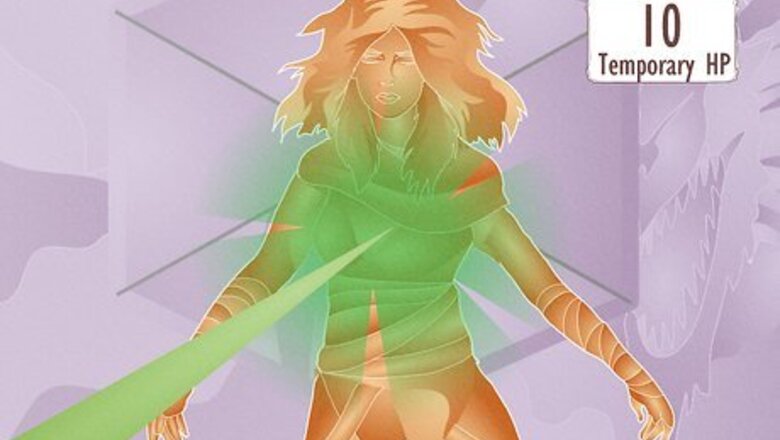
views
- Temporary hit points boost a character’s resilience and give them the ability to take increased damage in combat without falling unconscious.
- If you get attacked, subtract the damage from your temporary HP pool first. If the damage exceeds that value, subtract the remainder from your normal hit points.
- Temporary HP doesn’t stack and can’t be used to revive unconscious characters. However, characters whose healing is disabled can still gain temporary HP.
What are temporary hit points in D&D 5e?
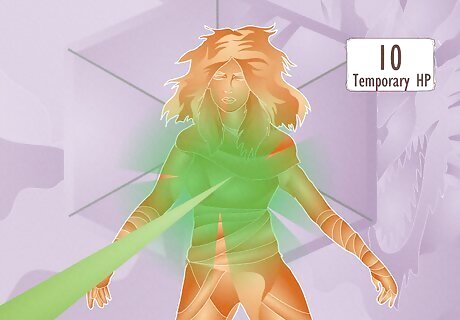
Temporary hit points boost a character’s ability to withstand damage. Hit points (also called “HP”) are a pool of points that measure how much damage they can take before passing out. Therefore, temporary HP is an additional pool of HP that can be added to your character’s base HP score, extending their health and durability. The more temporary HP your character has, the greater their ability to keep fighting while being hit by enemy spells and weapons. In short, temporary hit points represent an increase in your character’s HP pool for a limited amount of time. Temporary HP typically lasts either until depleted or until your character takes a long rest unless otherwise specified. Temporary HP can be the difference between life and death in difficult battles when your character might need a little extra health (or when you need to conserve health potions and healing spells). In D&D 5e, a character’s hit point total is determined by their class, Constitution ability score, and any additional bonuses from magic items or spells.
Mechanics of Temporary Hit Points in D&D 5e
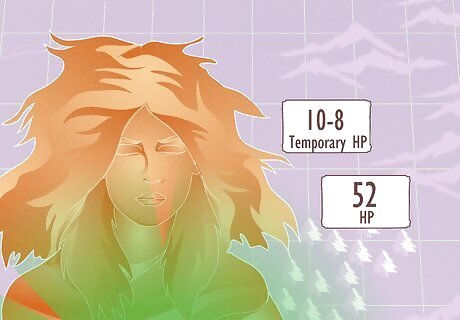
Subtract temporary HP first when your character takes damage. Although they supplement your character’s normal HP pool, temporary hit points must be tracked separately because they won’t last forever. When taking damage with temporary HP, be sure to subtract the temporary HP first—and only start subtracting regular HP when the damage total exceeds the amount of temporary HP your character has. For example, say your character has 52 regular hit points and 10 temporary hit points. If an enemy attacked you and dealt 8 points of damage, you’d subtract 8 from the pool of 10 temporary HP. If the enemy attacked again and dealt 5 more points of damage, you’d subtract the final 2 hit points from your pool of temporary HP and the remaining 3 from your regular pool of HP. Therefore, after the second attack, your character would have no temporary HP and 49 remaining regular HP. Think of temporary HP like a shield. It absorbs damage for your character until a certain point, and your character only takes damage once the temporary HP is depleted.
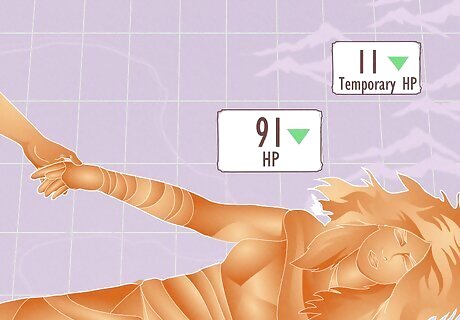
Temporary hit points aren’t the same as regular hit points. While HP and temporary HP have the same function, their mechanics differ. In D&D, characters fall unconscious when their hit point total is reduced to 0. To be revived, they need at least 1 hit point worth of healing—but temporary HP doesn’t count. Temporary hit points can’t be used to wake an unconscious ally; they’ll have to make death saving throws until they’re properly healed with a spell or potion. Temporary hit points also don’t count when it comes to spells that base their effects on how many hit points a creature has. Spells like Color Spray, Sleep, and Power Word Kill all take a character’s hit point total into consideration—and temporary HP doesn’t count toward this total. For example, Power Word Kill is a fairly straightforward (and brutal) spell: a creature with less than 100 HP is instantly killed by it. So, if your character had 91 hit points and 11 temporary hit points (for a total of 102), the spell would still drop them because their regular hit point total is below 100.
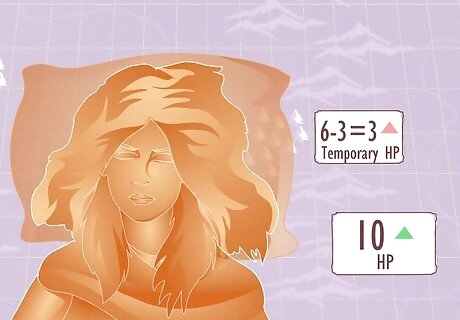
Your character can’t recover temporary hit points after losing them. Temporary hit points are just that: temporary. A character’s regular hit point pool can always be replenished by resting or healing, but once temporary HP is gone, it’s gone permanently. If you take damage and lose temporary hit points as well as regular hit points, healing will only restore the regular hit points you lost. For example, say you had 6 temporary HP and took 3 points of damage, which is absorbed by the temporary HP. If the party’s cleric cast Healing Word on you, those 3 lost temporary HP wouldn’t be restored. Therefore, make sure you only use healing spells and potions to restore actual HP—not temporary HP! Still, losing temporary HP doesn’t mean you’ll never get any again; you can get more the next time someone uses a spell or ability that grants temporary HP.
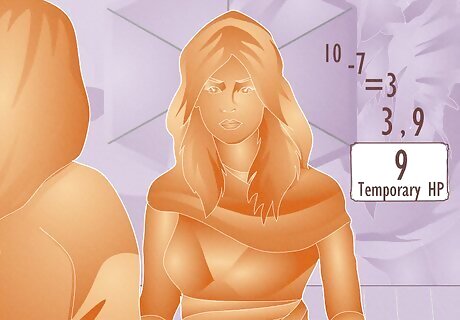
Temporary hit points don’t stack from multiple effects. In other words, once you have temporary hit points, you can’t get more and add them to the existing total. Still, there’s an upside: if you’re granted temporary HP when you already have it, you can choose the larger of the two values as your new current temporary HP total. That’s why it never hurts to have a little temporary HP; you can always replace it when someone else offers more! For example, say you’re playing D&D and have 10 temporary hit points at the start of the day, but you take 7 points of damage while tackling a pickpocket at the city market, leaving you with 3 temporary HP. Then, partway through the day, another character offers to make a speech using their Inspiring Leader feat, which would grant 9 temporary HP. You could choose to take the 9 instead, meaning you’d lose those 3 unused temporary hit points, but your temporary hit point total would still increase to 9—which is a good thing!

Your character can still gain temporary HP if they can’t heal. Some nasty spells and abilities (like the Chill Touch spell) may actually prevent your character from healing and regaining normal hit points for a limited time. This can spell grave danger for an injured character—but luckily, you can still gain temporary HP even when you can’t heal. This makes temporary HP invaluable! For example, if your character is affected by Chill Touch and only has 10 hit points left, that means they’re stuck with 10 HP until they can heal once more. However, if an ally casts Heroism, your character would gain an additional 6 temporary hit points, even while affected by the spell.
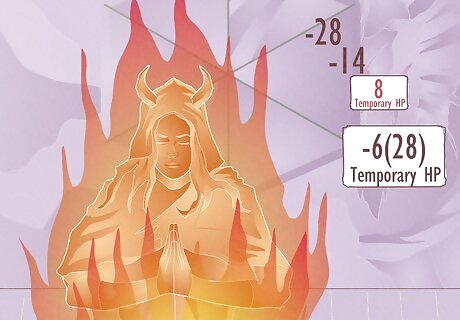
Take resistances into account before subtracting temporary HP. In D&D 5e, “resistance” measures a creature’s ability to shrug off a specific type of damage. Characters can have resistances to things like fire, cold, lightning, poison, and psychic damage—and, when they have a resistance to a particular kind of damage, you can halve the total whenever an enemy uses that damage against you. This is a very useful perk—and it works with temporary HP. For example, if you make a tiefling character with fire resistance and they get hit by a Fireball spell for 28 points of fire damage, they wouldn’t actually take that much damage. Half of 28 is 14, so your tiefling would take 14 points of fire damage. Then, if they had 8 temporary hit points, those temporary hit points would absorb part of the 14 points of fire damage. That means, after calculating resistance and subtracting temporary HP, your character would really only take 6 points of fire damage out of the 28 they could’ve taken!
How to Gain Temporary Hit Points
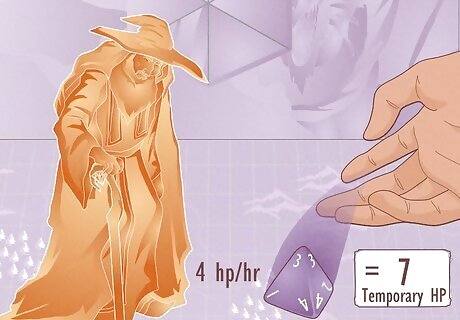
False Life spell False Life is a 1st-level necromancy spell available to sorcerers and wizards. Upon casting the spell (which takes an action), you’ll immediately gain 1d4 + 4 temporary hit points for 1 hour. That means you’ll roll a d4 dice (4-sided dice) and add 4 to that total to find out how many temporary hit points your character gets. For example, if you roll a 3 on your d4, then 3 + 4 grants a total of 7 temporary HP. Because False Life lasts for an hour, it’s easy to cast before entering a hostile area where you think you might encounter enemies (and combat). If your character is a warlock, you can give them the Fiendish Vigor eldritch invocation, which lets them cast False Life at will.
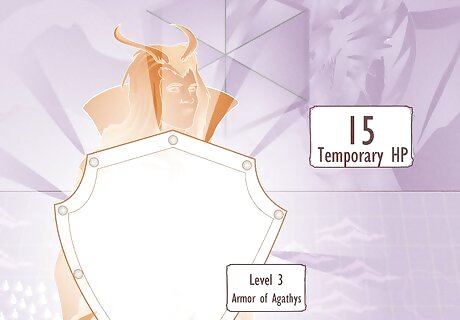
Armor of Agathys spell Armor of Agathys is a 1st-level abjuration spell available to warlocks. When cast, it surrounds your character with shielding spectral frost, granting 5 temporary hit points for 1 hour. Additionally, creatures that attack your character automatically take 5 points of cold damage—and when you cast the spell at higher levels, your character gets 5 extra temporary HP per level. So, for example, if you cast Armor of Agathys at level 3, your character will get 15 temporary HP instead of 5.
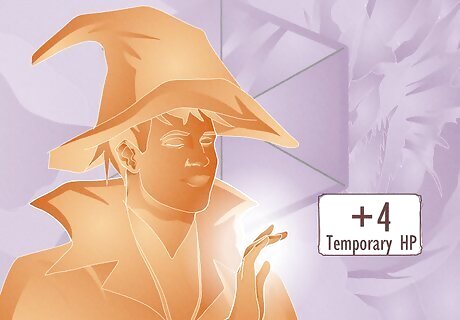
Heroism spell Heroism is a 1st-level enchantment spell available to bards and paladins. Upon casting Heroism, you can give a willing creature of your choice immunity to being frightened and temporary hit points equal to your spellcasting ability modifier. Your character’s spellcasting ability modifier is a value based on their main spellcasting ability score, which determines the effectiveness of spells. For example, if your character has a spellcasting ability modifier of +4, then Heroism can grant creatures 4 temporary hit points.
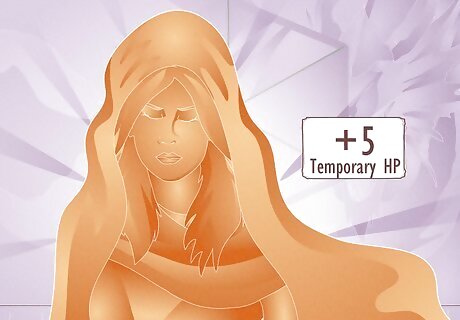
Mantle of Inspiration ability If you decide to play a musically-inclined bard with the College of Glamour subclass, you’ll get a version of the Bardic Inspiration class ability called Mantle of Inspiration. This ability lets you give allies within 60 feet 5 temporary HP (or 8 at 5th level, 11 at 10th level, and 14 at 15th level). Additionally, creatures who get temporary HP can use a reaction to move without provoking opportunity attacks.
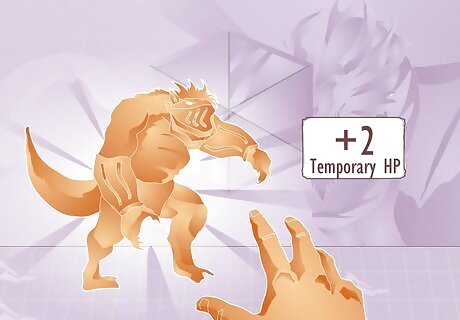
Storm Aura ability You’ll get this ability if you play a barbarian with the Storm Herald subclass (as seen in the Xanathar’s Guide to Everything 5e supplement). With the Storm Aura (tundra) feature, each creature of your choice within 10 feet of you gets 2 temporary HP. Additionally, the number of temporary HP you grant goes up by level; you’ll grant 3 HP at 5th level, 4 at 10th level, 5 at 15th level, and 6 at 20th level.
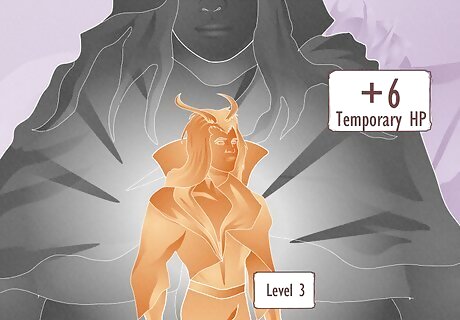
Dark One’s Blessing ability If you’re playing a warlock and chose The Fiend as their patron, you’ll get the Dark One’s Blessing ability at level 1. This grants temporary hit points equal to your character’s Charisma modifier + their warlock level whenever they drop to 0 hit points, essentially preventing them from immediately falling unconscious the first time their hit point pool is depleted. For example, if your warlock is level 3 and has a +3 Charisma modifier, they’ll gain 6 temporary HP instead of falling unconscious when they’re reduced to 0 HP. At level 5, you can also give your warlock the Tomb of Levistus eldritch invocation, which lets them use a reaction after taking damage to encase themselves in ice, granting 10 temporary HP for each warlock level. So, if your warlock is level 5 and uses the Tomb of Levistus invocation, they’ll get a whopping 50 temporary HP!
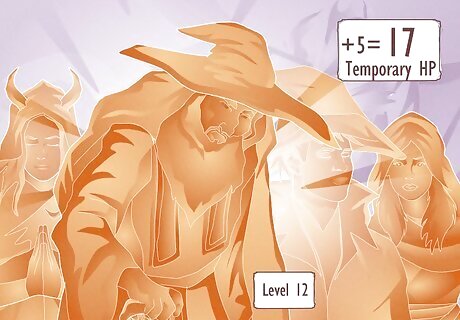
Inspiring Leader feat In D&D 5e, feats are basically additional perks or abilities you can choose for your character periodically when they level up. The Inspiring Leader feat is particularly useful for characters with high Charisma ability scores like bards, paladins, and sorcerers. With the feat, your character can spend 10 minutes giving an inspiring speech and grant up to 6 allies temporary HP equal to your level + your Charisma modifier. When you roll ability scores for a character, Charisma is the ability that measures a creature’s force of personality, charm, and eloquence. Your character’s Charisma modifier is a value based on their overall Charisma score. The modifier can be added to Charisma-based ability checks and saving throws, affecting their chances of success. For example, say your character is level 12, and their Charisma modifier is a +5. That means you could potentially give an inspiring speech that grants 17 temporary HP!
How to Add Flavor to Temporary Hit Points
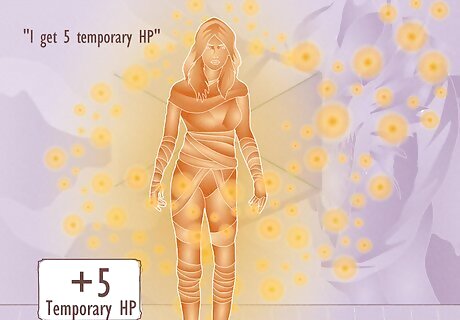
Find creative ways to depict characters gaining temporary HP in-game. Whether you want to be a DM (dungeon master) or a player, adding a little flair to your descriptions can make getting temporary HP more dynamic than simply saying, “I get 5 temporary hit points.” Try tailoring the description to your character’s class—or to the ability granting them temporary HP! For example: A righteous cleric might describe their temporary hit points as a shimmering golden barrier of light that keeps thinning out until it dissipates upon taking enough damage. A warlock with a Fiend (or Great Old One) patron might describe their temporary HP as a dark, shadowy aura that absorbs enemy attacks. If your character mainly makes physical attacks (as a barbarian or fighter, for example), you might describe temporary HP as pure adrenaline or the determination to win, even if it means going beyond your normal limits.



















Comments
0 comment